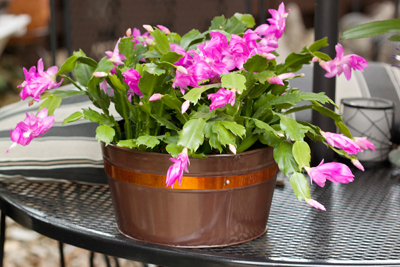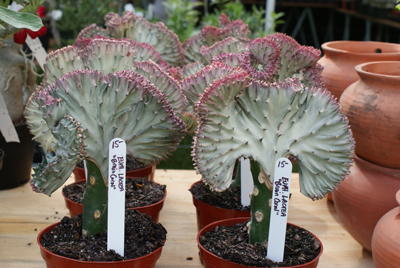What to do with holiday rescue plants

BY KENNETH SETZER
As published in the Miami Herald, 1/3/15.
All those sad-looking plants that no one bought—now is the time for you to swoop in and rescue them at bargain prices. Holiday gift plants can provide you with beauty long past the winter celebrations. Here are some I recommend you take home from the hardware store sale area.
A quick detour first, before we hit the stores. If you have a real tree sitting in your living room that you need to get rid of soon, I feel you. After you strip the poor thing of ornaments, a nice way to reduce landfill and increase your garden’s fertility is to recycle the tree as mulch. I haul mine into the backyard and using hand clippers simply cut up the smaller branches into the smallest pieces I can manage without losing my mind. Then I spread them over open areas where they will decompose into the soil and keep down weeds. I also spread the finer needles at the base of plants preferring a more acidic soil. It smells good, looks pretty nice and nourishes your plants. We all win. Of course adding smaller branches and needles to a compost pile is also a nice idea. Now you can discard the trunk, or cut it up (careful, and it gets sappy) and let it decompose in your yard and serve as home for countless critters of all sizes.
Ok now on to the store. You will encounter dozens of forlorn-looking plants, many in foil-wrapped pots or even worse—sprayed with glitter. I bet you’ll nearly trip over the unbought “mini Christmas trees” littering the ground. They are likely Cook pines (Araucaria columnaris) or Norfolk pines (A. heterophylla). These are in the Araucaria genus, not pine trees at all, but like pines, they are conifers. These little plants can grow to over 100 feet tall in their native habitats of New Caledonia and Norfolk Island, respectively. Araucarians are of an ancient lineage, now naturally found in the Southern Hemisphere, and include the “living fossil” Wollemi pine. Before you rescue one of these, keep in mind they quickly grow extremely tall and are forbidden by some municipalities and homeowners’ associations. Growing one in a pot is an option, but you might one day need to come to terms with a plant too big to keep potted.
Christmas cactus is a term applied to so many different plants! Many are actually cacti, some are not. Schlumbergera is a genus of cactus, and a common one you will find in stores. There are multiple cultivars, hybrids, varieties or whatever the grower wants to call them, but the Schlumbergera offered as holiday plants characteristically have flattened, pad-shaped, segmented stems. The younger plants grow upright and look great in a pot, and as they grow will flow out and down pendulously. They are naturally epiphytes, so make ideal hanging plants; I encourage you to grow some in hanging coconut coir pots, which drain well and unlike plastic are renewable. Unlike what you may envision for cacti, these grow naturally in cool, humid areas of southeastern coastal Brazil. Too much light will turn the stems reddish, while too little inhibits flowering. I find covered patios a perfect area for hanging Schlumbergera. Dozens of cultivars can be found and will flower in white, pink, yellow, orange, red, crimson, magenta or purple—basically the entire crayon box, with the yellow flower being a more recent creation. They do seem to like more fertile soil than many typical desert cacti, but the soil still needs to be well draining and not clumpy. Hummingbirds are their natural pollinators (witness the long flowers), but barring pollination, you can easily propagate them with a cutting of a couple segments. Allow the severed end of the cutting to dry and form a callus before placing into potting mix. Schlumbergera are said to need about 14 hours of darkness to flower, which we nearly get in South Florida in winter, but our warmer winter temps might be responsible for the profusion of blooms these cacti invariably supply.
Another gift plant is the bromeliad. Any of these on sale are a good bet—bromeliads are tough and easily survive my benign neglect approach to gardening. What’s odd is they are most marketable when blooming, but right after flowering, bromeliads begin to die. However, they will first likely produce numerous pups from their roots, similar to sending up suckers. When the pups are about half as large as the mother, you can carefully pull them off and plant them elsewhere.
I leave you with one final post-holiday plant, Euphorbia. These are often mistaken for cacti, since some may have spines, but euphorbias are succulents in a different family along with poinsettias. The one to look for is often called “cristate, crested” or “brain coral.” These indeed look like coral, or the undulations of a brain. The formation is said to be fasciated, a flattened growth deformity found in many plants. The euphorbia’s abnormal growth has been cultivated and is actually the plant’s selling point. These are quite beautiful, and don’t worry about the deformity; it’s harmless and won’t spread to other plants. In fact, I search for fasciated plants because they are so striking. Most crested euphorbias are grafted onto a base plant supposedly to prolong the life of the crested part. I have no idea why these are associated with holidays. In Fairchild’s Lougheed Spiny Forest of Madagascar exhibit, you can view a dramatically fasciated Pachypodium (Pachypodium lamerei ‘Cristata’) in Plot 31, but this one’s not for sale.



